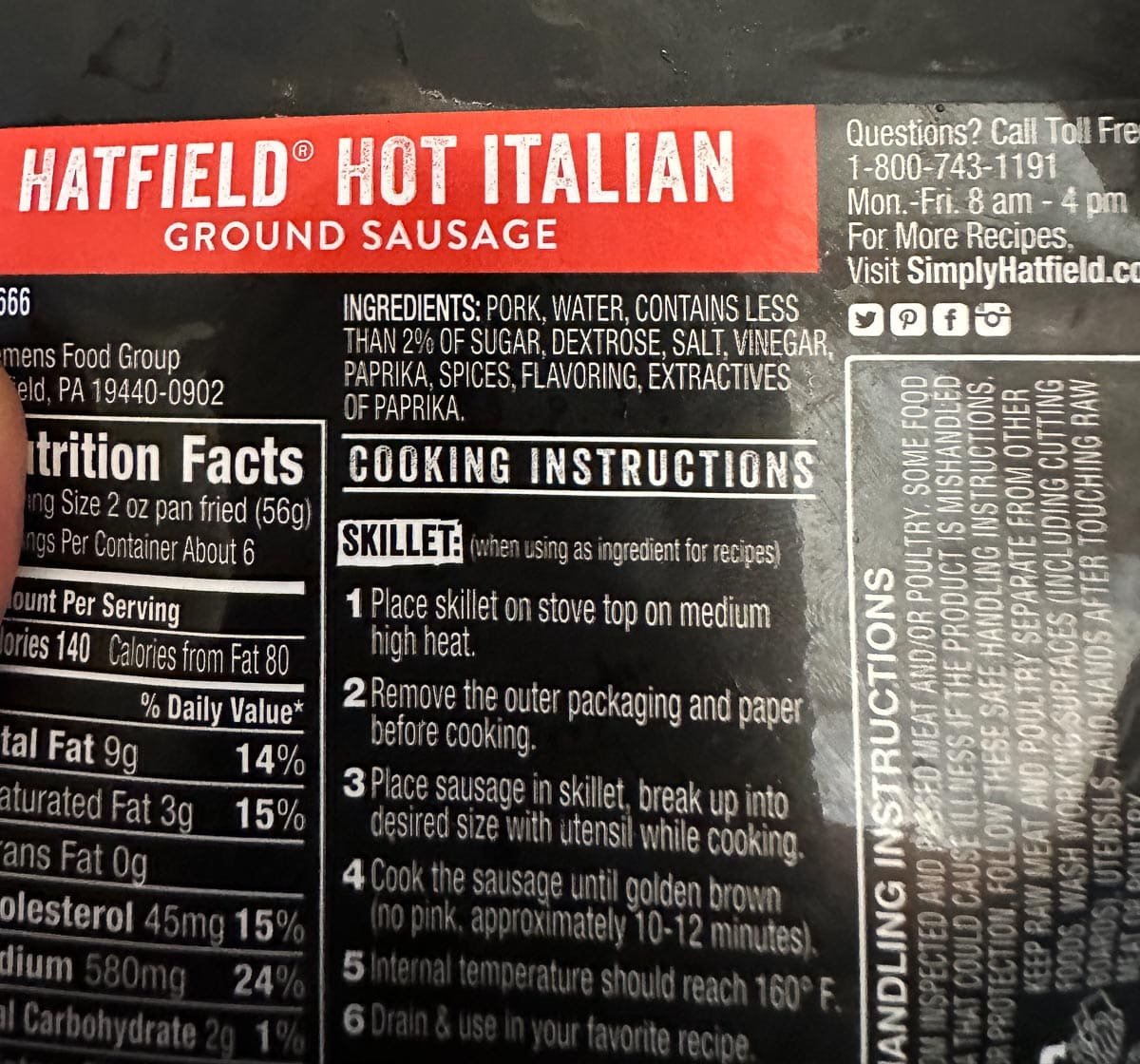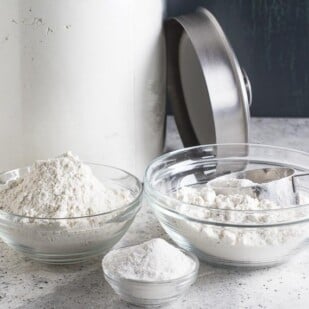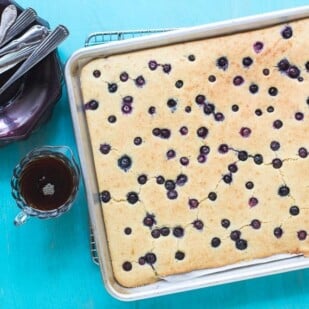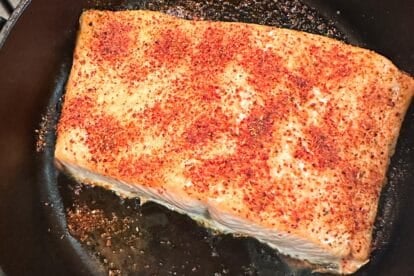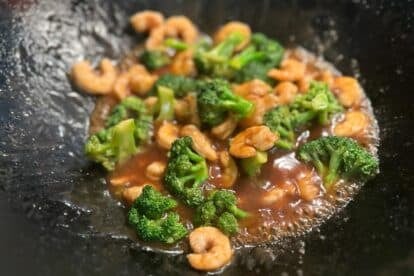Sheet Pan Lasagna is exactly what it sounds like. Our version is made with low FODMAP lasagna, made in a sheet pan, no painstaking layering needed! All the flavors and ingredients that you love in lasagna in a simple sheet pan form.
We start with low FODMAP gluten-free lasagna noodles, broken up into pieces, then of course we have marinara sauce, lactose free ricotta, naturally lactose-free mozzarella and Parmesan, and we have added spinach and spicy sausage. Once you make lasagna like this you were wonder where this technique has been all your life.
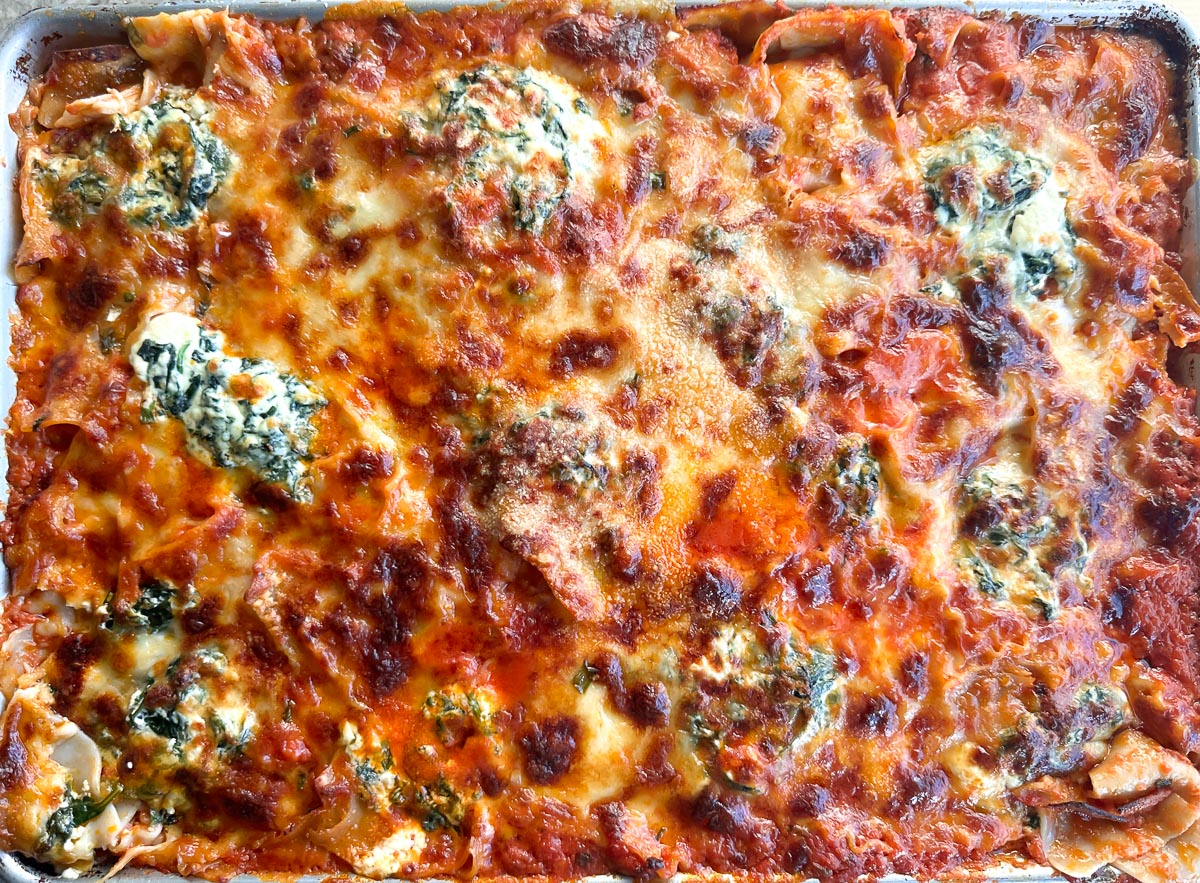
Low FODMAP Marinara Sauce
For the marinara sauce you can use your favorite low FODMAP version, homemade or purchased. For the lasagna in the photos, I used Rao’s Sensitive Marinara, which is a very high quality low FODMAP prepared option. You want a well-flavored marinara sauce, and not just plain tomato sauce from a can.
Frequently Asked Questions
Yes, there are many cheeses that are low FODMAP and lactose-free.
Many people mistakenly believe that the low FODMAP diet is dairy free, but it is not. It is lower in lactose,and you will be thrilled to learn that many cheeses, such as mozzarella and Parmesan, are naturally lactose free and therefore appropriate even during the Elimination Phase of the low FODMAP diet.
When it comes to softer and fresh cheeses like ricotta, they are higher in lactose – but according to Monash University lab testing, conventional ricotta does have a 2 Australian tablespoons(40 g) serving size,
You have a few options. You can make our low FODMAP ricotta, which is much easier than do you think, or if you have access to commercially prepared lactose-free ricotta, certainly use that.
Three other routes you can take is either adding lactase enzyme to the ricotta to reduce the lactose amount, take a lactase enzyme when you enjoy this dish, or simply know that the amount called for in the recipe is low FODMAP (without taking Stacking into account) and if you digest lactose well, you might not have to make any changes. Know your tolerances.
We have an article that explains about the lactase enzyme in more detail called DIY Lactose–Free Dairy and we suggest that you take a moment to read that now.
Yes, sausage can be low FODMAP.
Sausage is one of those ingredients where you will have to read labels carefully. Look out for garlic in particular, but whenever label reading look for any high FODMAP ingredients. We have found it fairly easy to source sausages, like the spicy Italian sausage we used for this dish, with low FODMAP ingredients.
Also, we ask for the sausage to be removed from its casing; you might be able to find it without casing at the store, which will save you a prep step.
Remember, when ingredients are 2% or less on the label, they are considered unlikely to trigger IBS symptoms. Tolerance will vary and of course always eat to your tolerances.
You might want to review our article titled How To Decipher Natural Flavors & Spices on Food Labels for the Low FODMAP Diet.
Yes, you can. Just read labels and make sure it is low FODMAP.
You could, but it adds color, flavor and nutrition.
Tips for Making Low FODMAP Sheet Pan Lasagna
Please note that this recipe calls for a commercial grade half sheet pan. Half sheet pans have a specific dimension (18-inch x 13-inch with 1-inch rim/46 cm x 33 cm) and the ingredients for the lasagna will fill up every little part of the pan. So, if you’re pan is made out of flimsy material, or is smaller in dimension, I am warning you now that you are going to have marinara sauce and cheese overflowing.
Also, note on the chili flakes being optional. I have often found that the spiciness in my sausages is enough. Use your judgment.
How To Make Low FODMAP Sheet Pan Lasagna
Preheat the oven to 425°F (220°C). Use 1 tablespoon of the oil to grease the inside of a commercial weight half-sheet pan, bottom and sides; set aside.
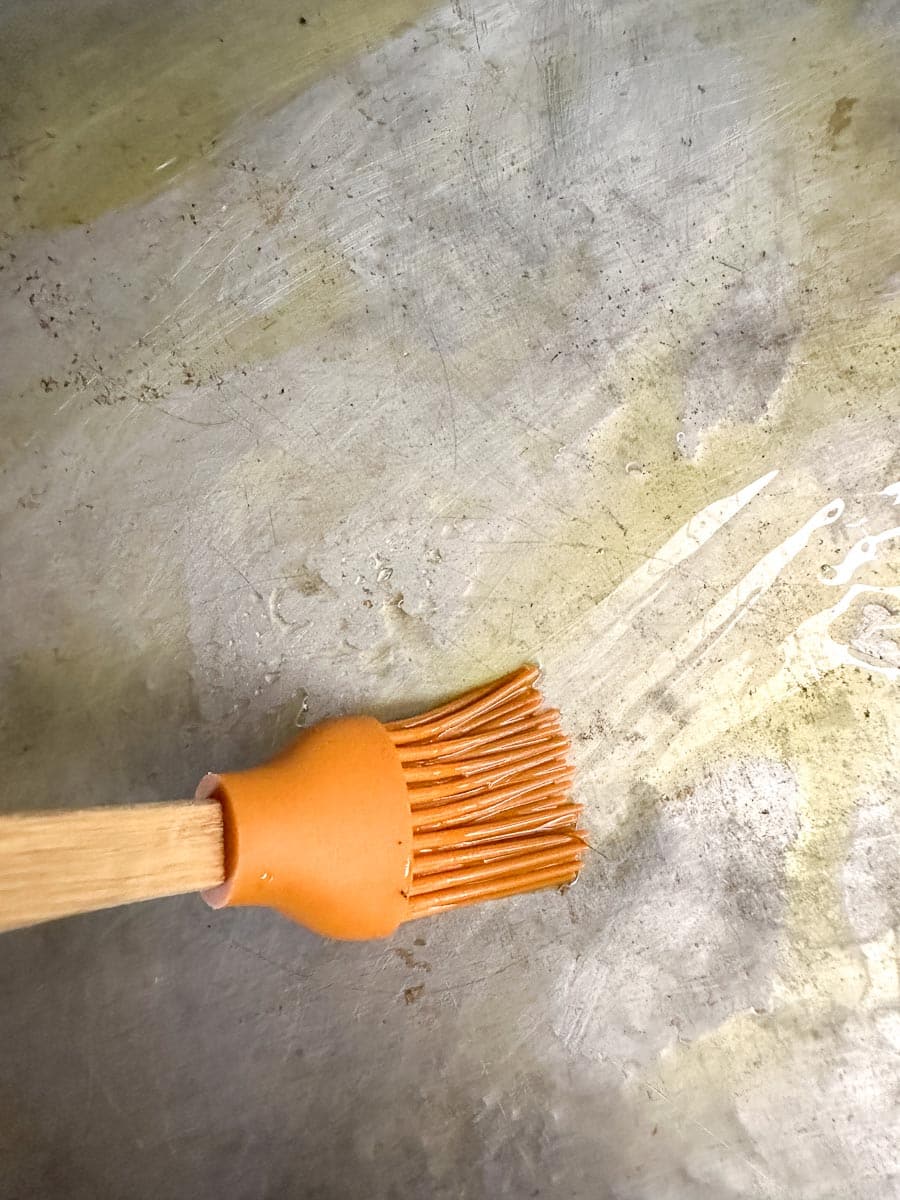
Bring a large pot of salted water to a boil over high heat. Break up the lasagna pieces.
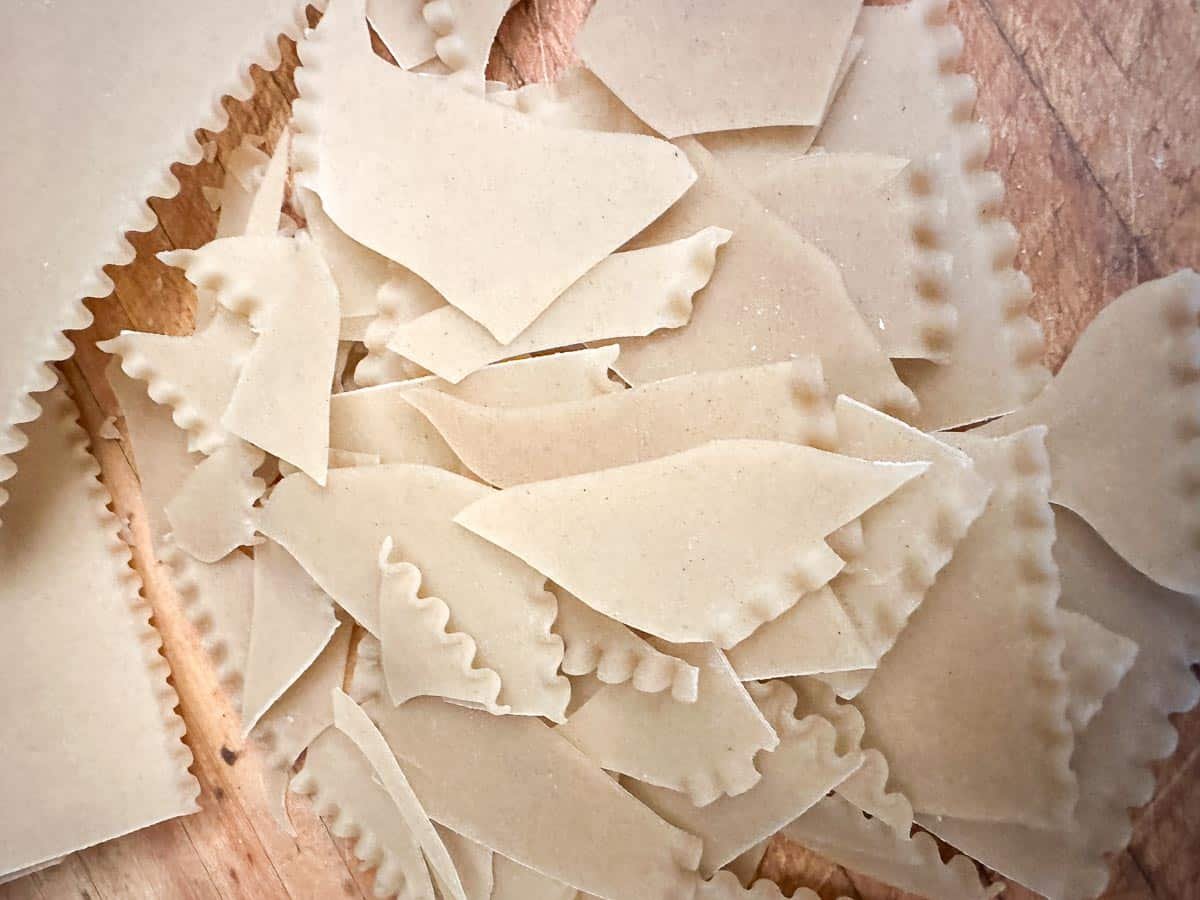
Add lasagna pieces to boiling water and cook, stirring often, until on the firm side of al dente. Remove ½ cup (120 ml) of the pasta water and reserve; drain the remaining pasta.
Meanwhile, heat 1 tablespoon of the oil in a large skillet over medium heat. Add the spinach and cook, stirring often, until the spinach is almost completely wilted.
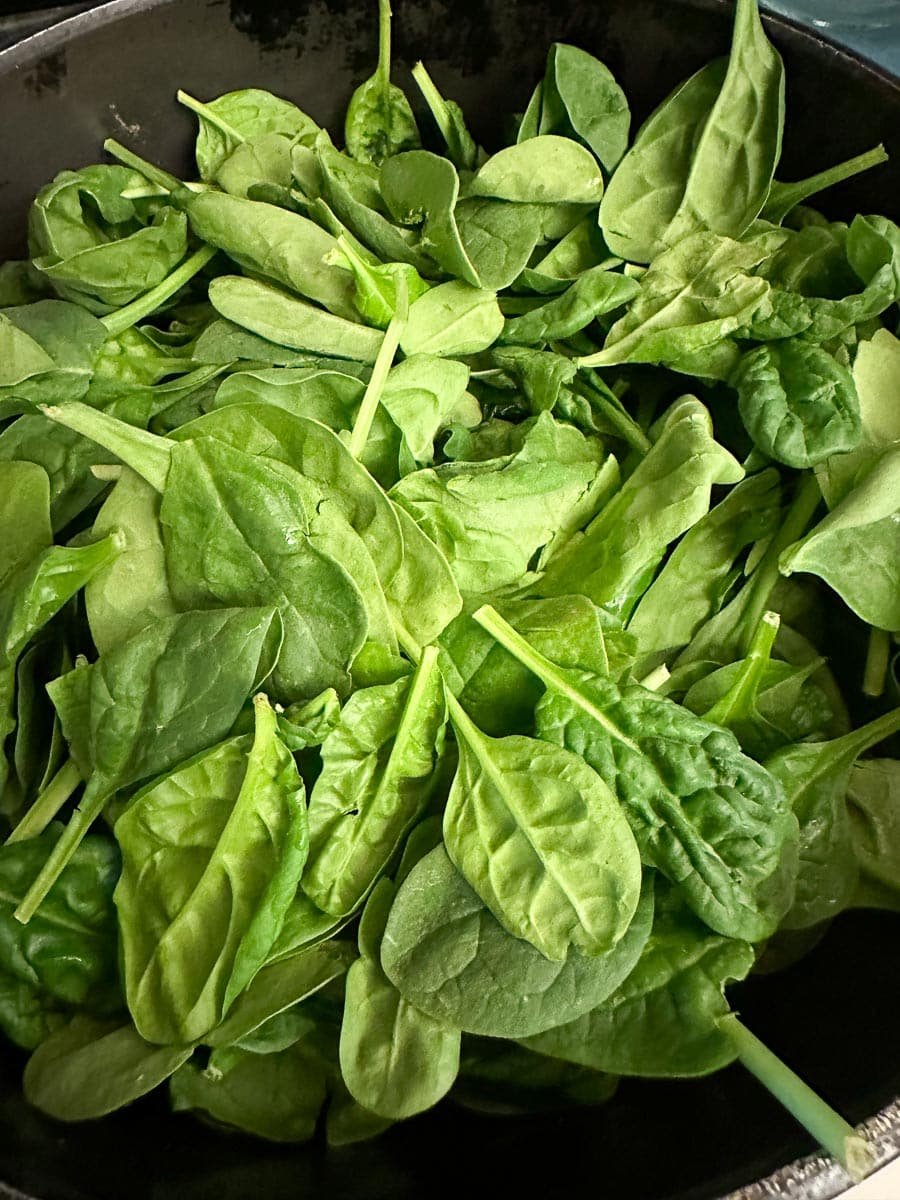
Remove the spinach mixture to a colander or strainer and press firmly to remove all excess liquid; take time to really dry out the spinach. Place the spinach in a medium-sized mixing bowl and use a pair of kitchen scissors to chop the spinach into bite-sized pieces. Add the ricotta cheese and stir to combine. Season lightly with salt and generously with pepper. Set aside.
Wipe out the skillet with paper towels and place over medium heat. Add the remaining 2 tablespoons of oil to the pan along with the sausage and cook, stirring often and breaking apart as needed, until the sausage is lightly browned, and cooked through, about 5 minutes. Add scallions and leek bulb to the pan and cook until the onion is fragrant and beginning to soften, about another 3 minutes.
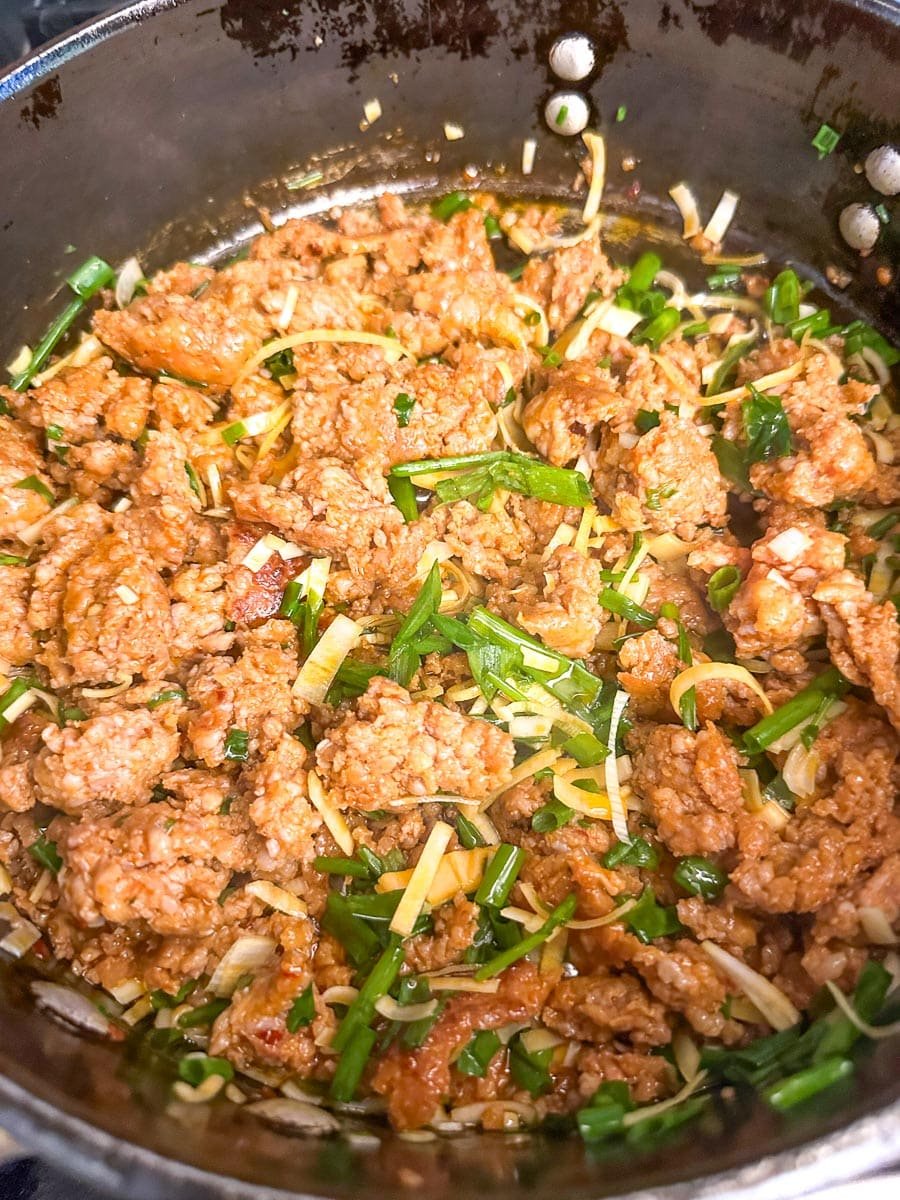
Stir in marinara sauce, and optional red pepper flakes, if desired. Remove from the heat.
Stir in the pasta, pasta water, and about one-third of the mozzarella and Parmesan; you can do this by eye.
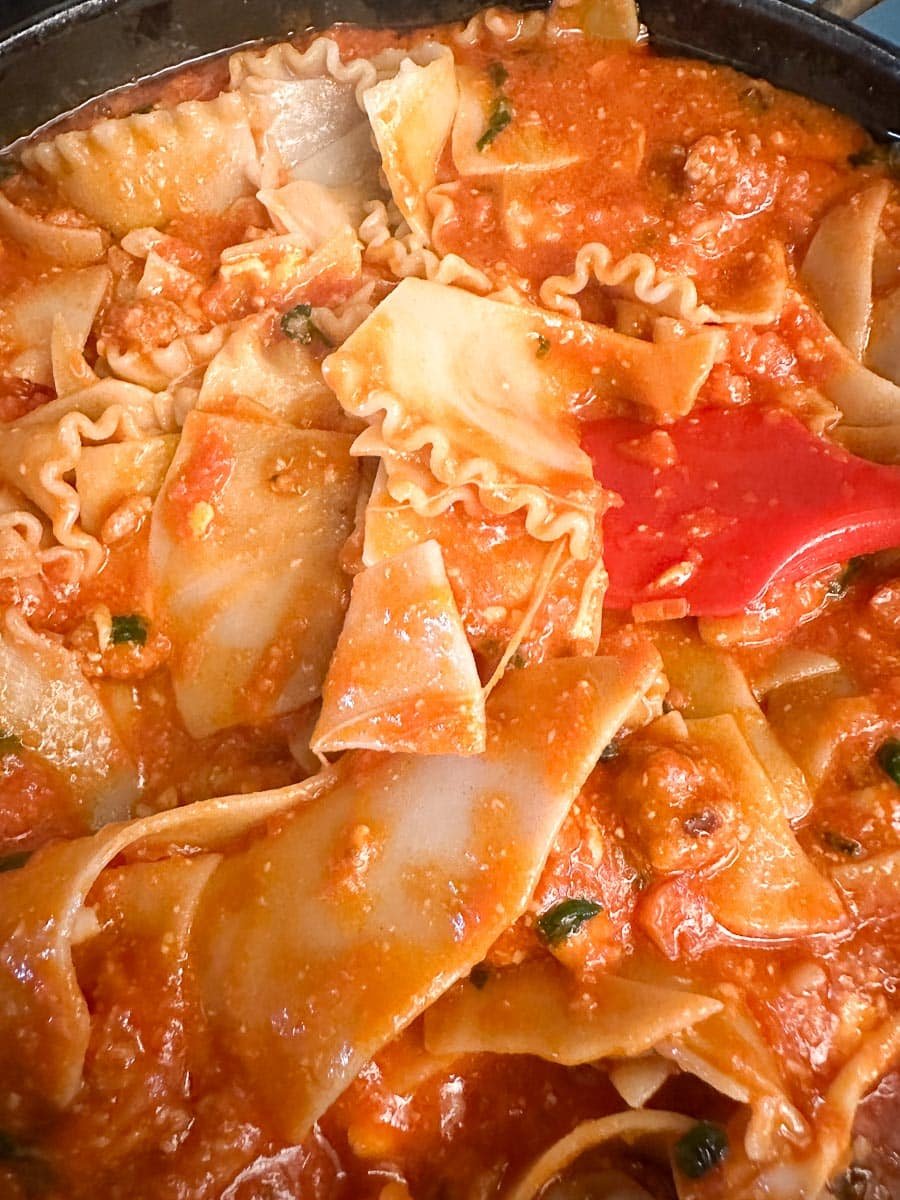
Spread the pasta mixture on the prepared pan.
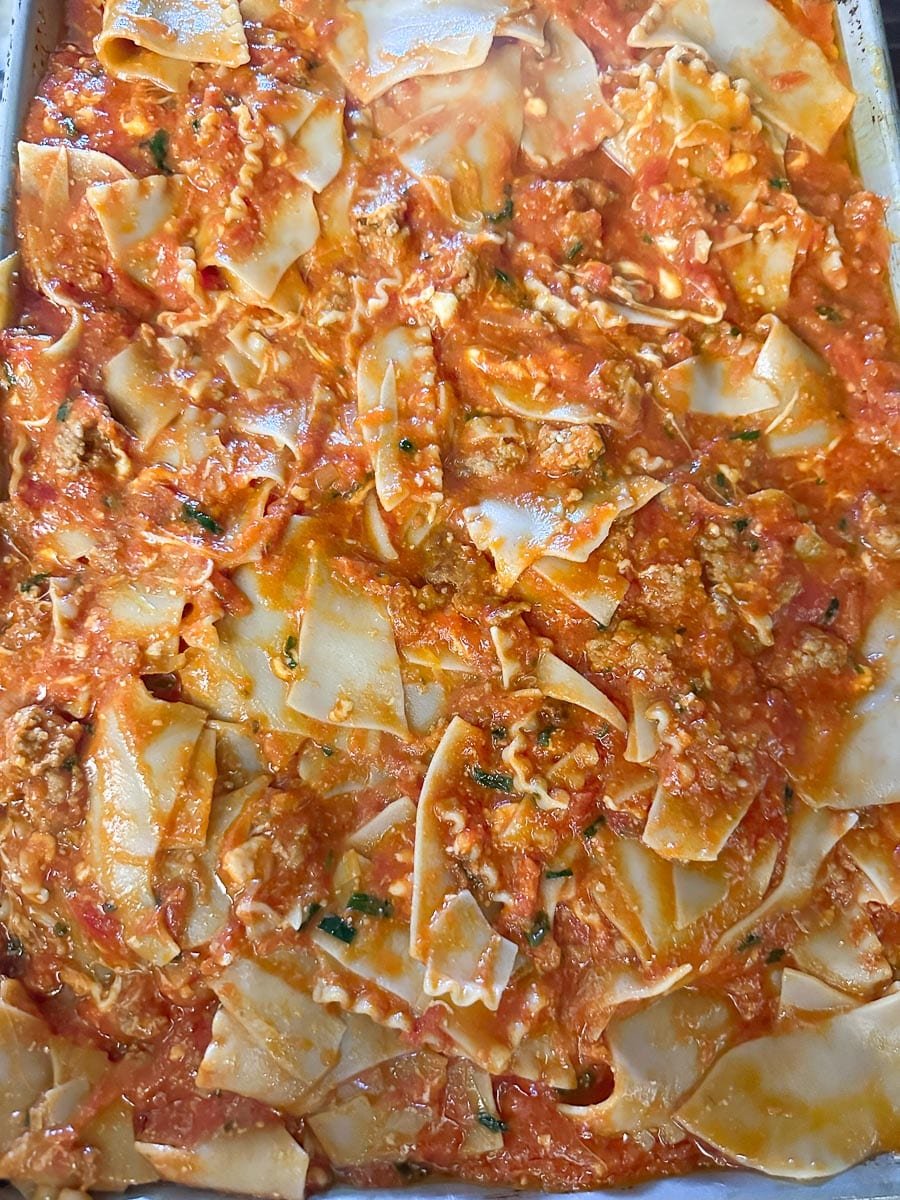
Dollop the ricotta-spinach mixture here and there.
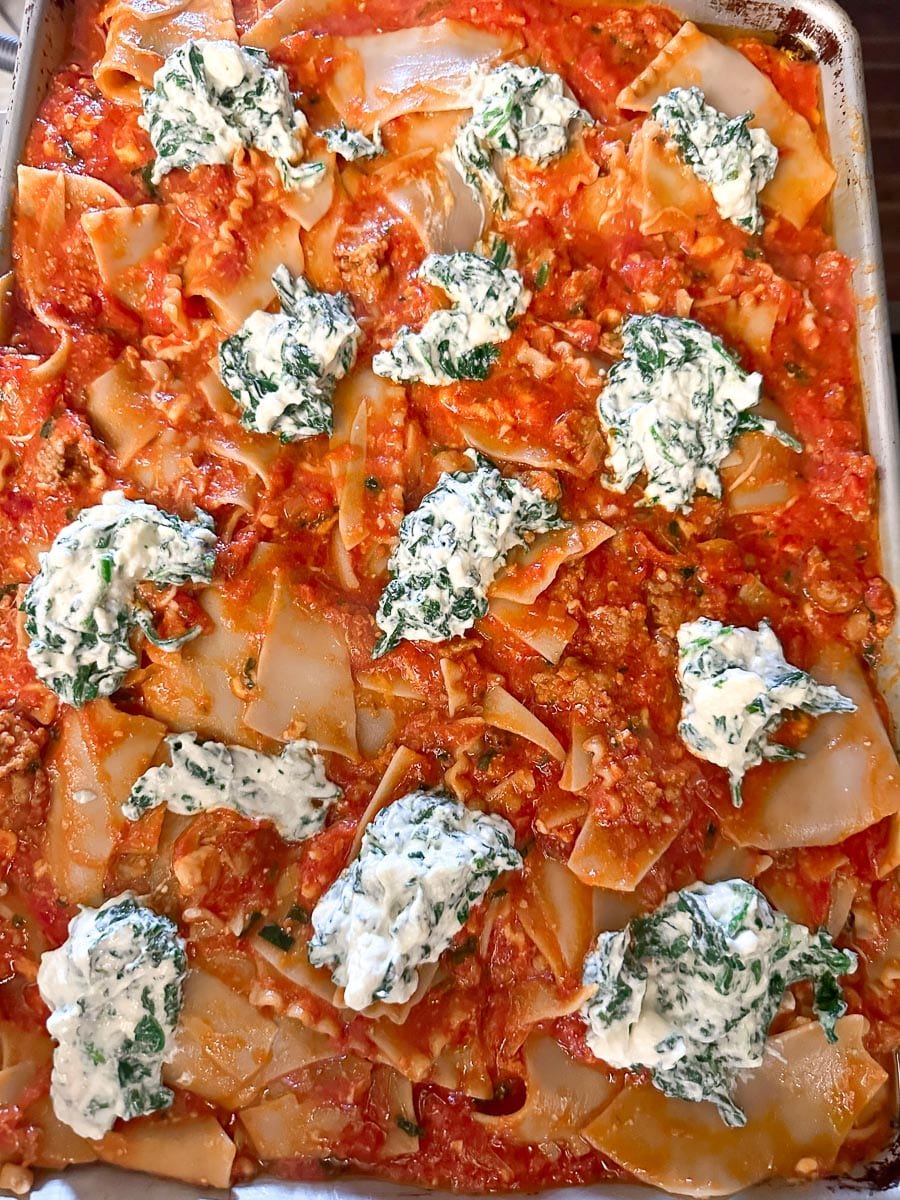
Then sprinkle with remaining mozzarella…
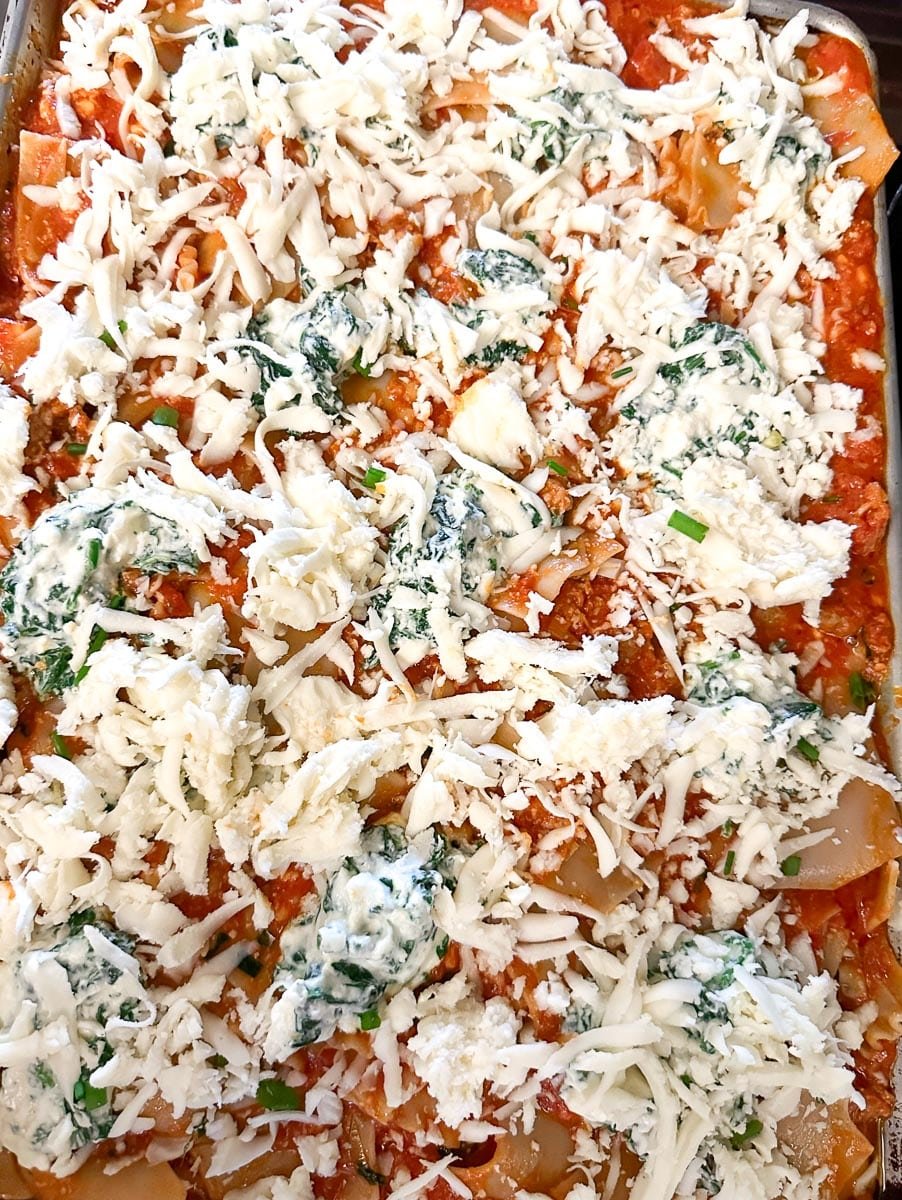
…and Parmesan.
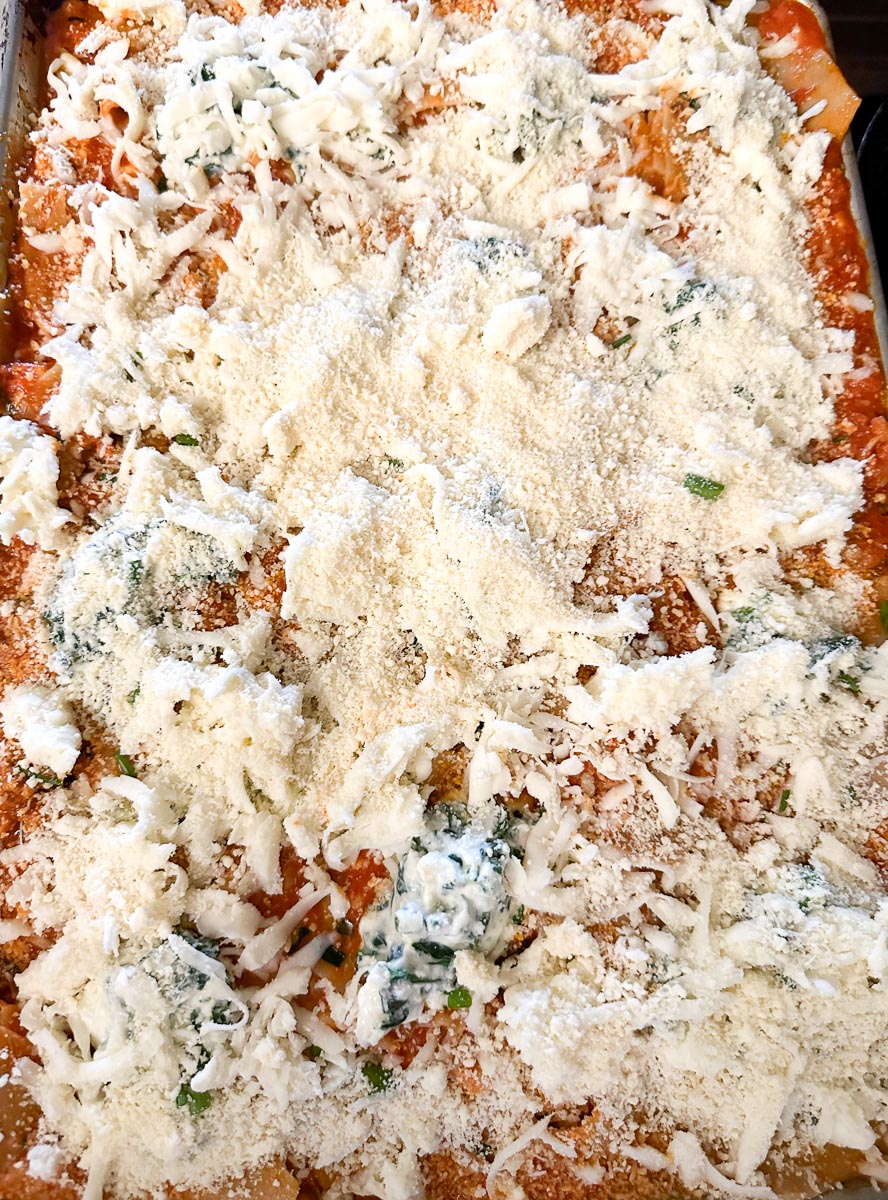
Bake until the pasta is tender, the sauce is bubbly, and the top is lightly browned, about 30 minutes.
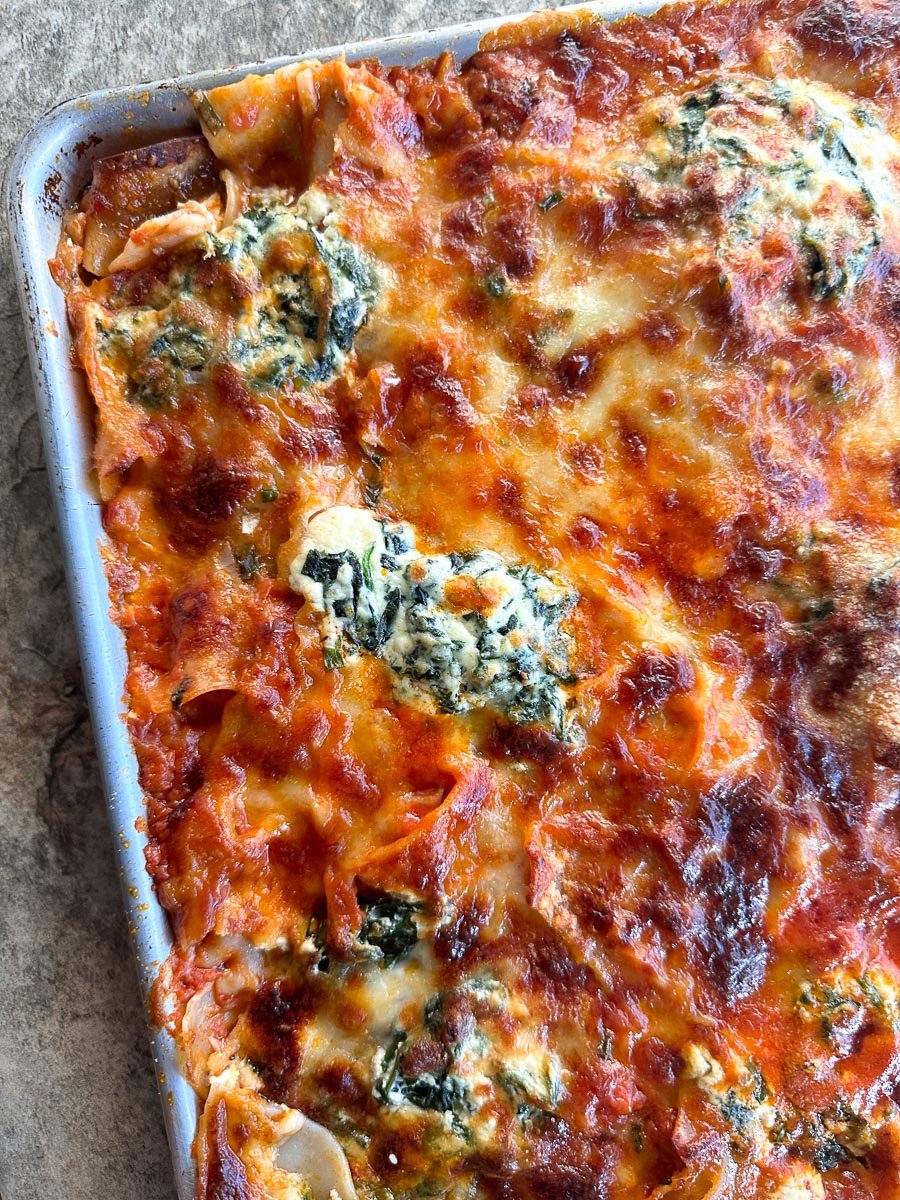
Remove from the oven and let rest for 5 minutes before serving. It might be a bit messy looking on the plate, but trust us, no one ever complains.
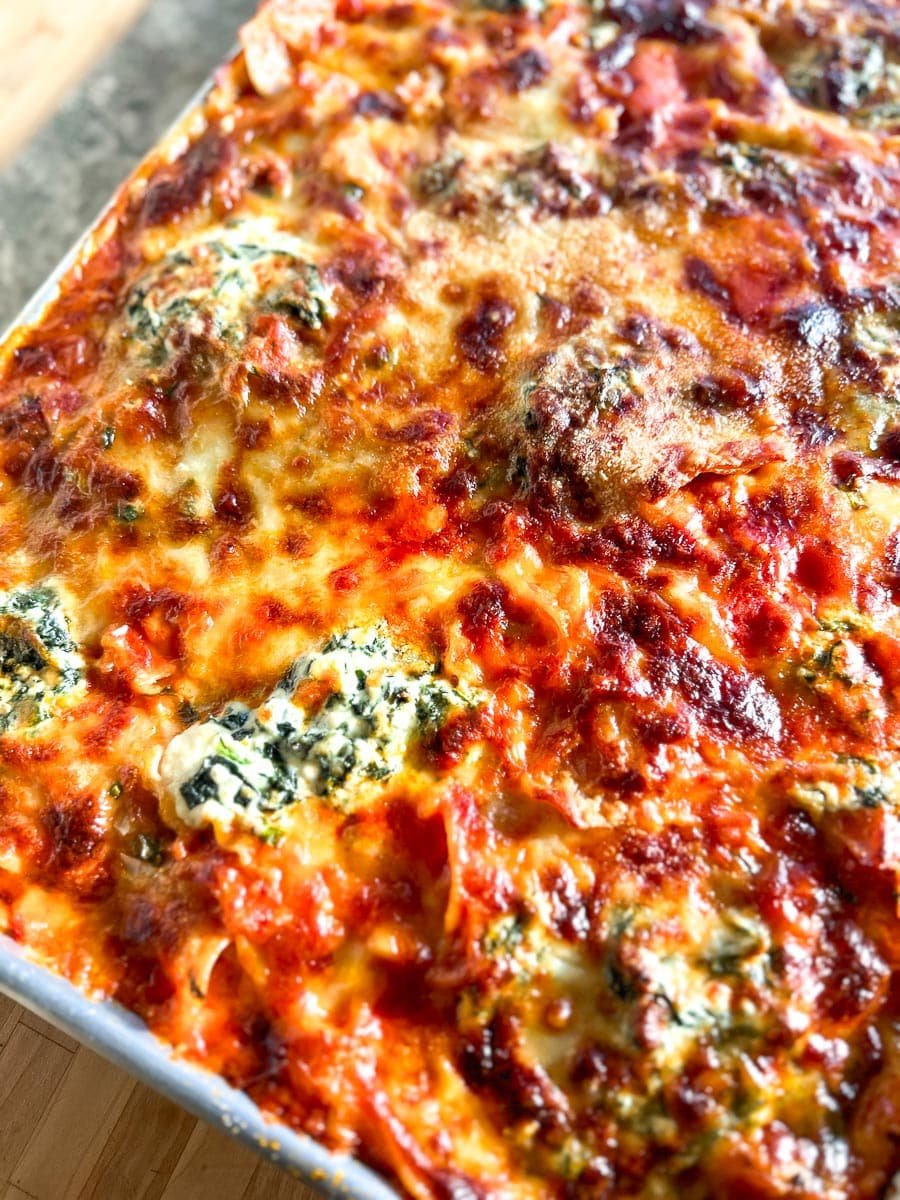
FODMAP Information
All recipes are based upon Monash University & FODMAP Friendly science at time of initial publication.
- Cheese: Many cheeses have low FODMAP serving sizes. The low FODMAP diet is not a dairy-free diet. Hard cheeses such as Parmigiano Reggiano or Pecorino Romano have been lab tested by Monash University and are low FODMAP in 40 g amounts – and the servings remain low FODMAP up to 500 g.
- Dairy: The low FODMAP diet is not a dairy-free diet. It is however, low in lactose. Many dairy ingredients are low in lactose, such as heavy cream and many cheeses.
- Garlic-Infused Oil: Make your own Garlic-Infused Oil or buy a commercial equivalent for the easiest way to add garlic flavor to your food. Fructans in garlic are not oil-soluble, so garlic-infused oil is low FODMAP.
- Lactose-Free Dairy: Lactose-free dairy, such as lactose-free milk or lactose-free cream cheese, has lactase enzyme added that breaks the disaccharide molecules and creates a more digestible dairy product, from a lactose perspective. The resulting product is not dairy-free, but it is lactose-free. Some products might have miniscule amounts of lactose remaining, but the amount is small enough for the product to be labeled as lactose-free. For instance, Breyers Lactose-Free Vanilla Ice Cream states it is 99% lactose-free, while Lactaid Vanilla Ice Cream states it is 100% lactose-free.
- Leeks: Both Monash University and FODMAP Friendly have lab tested leeks – greens (leaves) and bulbs. Monash University recommends a low FODMAP serving size of 100 g for the greens, and 14 g for the bulb. FODMAP Friendly suggests a serving size of leek greens of 37 g, with a low FODMAP max serve of 83 g. Their recommended low FODMAP leek bulb amount is 46 g.
- Pasta: Please note that small amounts (74 g) of conventional wheat-based pasta is low FODMAP Use your Monash app for more information; the diet is not wheat or gluten-free. If you are gluten-free, you have to read labels, as there are many low FODMAP gluten-free brands of pasta available, but remember that gluten-free does not equal low FODMAP. Use what is called for in individual recipes. Our go-to is rice-based pasta. Monash University and FODMAP Friendly have both tested “gluten-free” pasta, but they do not specify what the pasta was made from. Monash says gluten-free pasta is low FODMAP at 145 g or 1 cup cooked; FODMAP Friendly lab testing suggested 2 cups or 146 g cooked is low FODMAP. Monash has also lab tested pasta made from rice, which they list under “rice stick” and it is low FODMAP at 220 g, which no Moderate or High FODMAP amounts given.
- Scallions: Monash University lab testing found no FODMAPs detected in scallion greens; they suggest a 75 g serving size. FODMAP Friendly has also lab tested scallions: their recommended serving size for the green parts is 16 g, with a max low FODMAP serving of 161 g. They have also tested the bulb and it is low FODMAP in 19 g portions, which is about 2 tablespoons finely chopped.
- Spinach: Monash University and FODMAP Friendly have both lab tested spinach. Monash makes a distinction between “baby” spinach and what they call “English”, which appears to be a mature spinach. According to Monash, “baby” spinach has a low FODMAP serving size of 1 ½ cups or 75 g. The “English” type has a serving size of 2 cups or 75 g. FODMAP Friendly shows one kind of spinach (it is hard to distinguish what it is) and their lab tests show low FODMAP serving sizes of 2 cups or 75 g.
Please always refer to the Monash University & FODMAP Friendly smartphone apps for the most up-to-date lab tested information. Foods will be retested from time to time; in the case of raw ingredients, such as fruits and vegetables, results may vary. All lab tested results are valid and represent a snapshot in time. As always, your tolerance is what counts; please eat accordingly. The ultimate goal of the low FODMAP diet is to eat as broadly as possible, without triggering symptoms, for the healthiest microbiome.
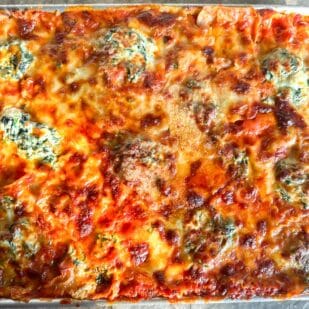
Low FODMAP Sheet Pan Lasagna with Spicy Sausage & Spinach
Low FODMAP Sheet Pan Lasagna is exactly what it sounds like. Low FODMAP lasagna, made in a sheet pan, no painstaking layering needed! All the flavors and ingredients that you love in lasagna in a simple sheet pan form. We start with low FODMAP gluten-free lasagna noodles, broken up into pieces, then of course we have marinara sauce, lactose free ricotta, naturally lactose-free mozzarella and Parmesan, and we have added spinach and spicy sausage. Once you make lasagna like this you were wonder where this technique has been all your life.
Ingredients:
- Kosher salt
- 1- pound (455 g) low FODMAP, gluten-free lasagna noodles, such as Jovial brand, broken into 2-inch (5 cm) pieces
- ¼ cup (60 ml) Garlic-Infused Oil, made with olive oil, homemade or purchased, divided
- 5- ounces (140 g) fresh baby spinach
- 1 cup (248 g) part skim or full-fat ricotta cheese; you can use lactose-free if make it, or can find it
- Freshly ground pepper
- 1- pound (455 g) low FODMAP spicy Italian sausage, casings removed if necessary
- ¾ cup (48 g) chopped scallions, green parts only
- ¼ cup (28 g) chopped leek bulb
- 4 cups (960 ml) low FODMAP marinara sauce, homemade or prepared
- 1/2 teaspoon red pepper flakes, optional
- 1- pound (455 g) shredded low moisture mozzarella, divided
- 1 1/2 cups (125 g) freshly grated Parmesan, divided
Preparation:
-
Preheat the oven to 425°F (220°C). Use 1 tablespoon of the oil to grease the inside of a commercial weight half-sheet pan, bottom and sides; set aside.
-
Bring a large pot of salted water to a boil over high heat. Add lasagna pieces and cook, stirring often, until on the firm side of al dente. Remove ½ cup (120 ml) of the pasta water and reserve; drain the remaining pasta.
-
Meanwhile, heat 1 tablespoon of the oil in a large skillet over medium heat. Add the spinach and cook, stirring often, until the spinach is almost completely wilted. Remove the spinach mixture to a colander or strainer and press firmly to remove all excess liquid; take time to really dry out the spinach. Place the spinach in a medium-sized mixing bowl and use a pair of kitchen scissors to chop the spinach into bite-sized pieces. Add the ricotta cheese and stir to combine. Season lightly with salt and generously with pepper. Set aside.
-
Wipe out the skillet with paper towels and place over medium heat. Add the remaining 2 tablespoons of oil to the pan along with the sausage and cook, stirring often and breaking apart as needed, until the sausage is lightly browned, and cooked through, about 5 minutes. Add scallions and leek bulb to the pan and cook until the onion is fragrant and beginning to soften, about another 3 minutes. Stir in marinara sauce, and optional red pepper flakes, if desired. Remove from the heat.
-
Stir in the pasta, pasta water, and about one-third of the mozzarella and Parmesan; you can do this by eye. Spread the pasta mixture on the prepared pan. Dollop the ricotta-spinach mixture here and there, then sprinkle with remaining mozzarella and Parmesan.
-
Bake until the pasta is tender, the sauce is bubbly, and the top is lightly browned, about 30 minutes. Remove from the oven and let rest for 5 minutes before serving. It might be a bit messy looking on the plate, but trust us, no one ever complains.
Notes:
FODMAP Information
All recipes are based upon Monash University & FODMAP Friendly science at time of initial publication.
• Cheese: Many cheeses have low FODMAP serving sizes. The low FODMAP diet is not a dairy-free diet. Hard cheeses such as Parmigiano Reggiano or Pecorino Romano have been lab tested by Monash University and are low FODMAP in 40 g amounts – and the servings remain low FODMAP up to 500 g.
• Dairy: The low FODMAP diet is not a dairy-free diet. It is however, low in lactose. Many dairy ingredients are low in lactose, such as heavy cream and many cheeses.
• Garlic-Infused Oil: Make your own Garlic-Infused Oil or buy a commercial equivalent for the easiest way to add garlic flavor to your food. Fructans in garlic are not oil-soluble, so garlic-infused oil is low FODMAP.
• Lactose-Free Dairy: Lactose-free dairy, such as lactose-free milk or lactose-free cream cheese, has lactase enzyme added that breaks the disaccharide molecules and creates a more digestible dairy product, from a lactose perspective. The resulting product is not dairy-free, but it is lactose-free. Some products might have miniscule amounts of lactose remaining, but the amount is small enough for the product to be labeled as lactose-free. For instance, Breyers Lactose-Free Vanilla Ice Cream states it is 99% lactose-free, while Lactaid Vanilla Ice Cream states it is 100% lactose-free.
• Leeks: Both Monash University and FODMAP Friendly have lab tested leeks – greens (leaves) and bulbs. Monash University recommends a low FODMAP serving size of 100 g for the greens, and 14 g for the bulb. FODMAP Friendly suggests a serving size of leek greens of 37 g, with a low FODMAP max serve of 83 g. Their recommended low FODMAP leek bulb amount is 46 g.
• Pasta: Please note that small amounts (74 g) of conventional wheat-based pasta is low FODMAP Use your Monash app for more information; the diet is not wheat or gluten-free. If you are gluten-free, you have to read labels, as there are many low FODMAP gluten-free brands of pasta available, but remember that gluten-free does not equal low FODMAP. Use what is called for in individual recipes. Our go-to is rice-based pasta. Monash University and FODMAP Friendly have both tested “gluten-free” pasta, but they do not specify what the pasta was made from. Monash says gluten-free pasta is low FODMAP at 145 g or 1 cup cooked; FODMAP Friendly lab testing suggested 2 cups or 146 g cooked is low FODMAP. Monash has also lab tested pasta made from rice, which they list under “rice stick” and it is low FODMAP at 220 g, which no Moderate or High FODMAP amounts given.
• Scallions: Monash University lab testing found no FODMAPs detected in scallion greens; they suggest a 75 g serving size. FODMAP Friendly has also lab tested scallions: their recommended serving size for the green parts is 16 g, with a max low FODMAP serving of 161 g. They have also tested the bulb and it is low FODMAP in 19 g portions, which is about 2 tablespoons finely chopped.
• Spinach: Monash University and FODMAP Friendly have both lab tested spinach. Monash makes a distinction between “baby” spinach and what they call “English”, which appears to be a mature spinach. According to Monash, “baby” spinach has a low FODMAP serving size of 1 ½ cups or 75 g. The “English” type has a serving size of 2 cups or 75 g. FODMAP Friendly shows one kind of spinach (it is hard to distinguish what it is) and their lab tests show low FODMAP serving sizes of 2 cups or 75 g.
Please always refer to the Monash University & FODMAP Friendly smartphone apps for the most up-to-date lab tested information. Foods will be retested from time to time; in the case of raw ingredients, such as fruits and vegetables, results may vary. All lab tested results are valid and represent a snapshot in time. As always, your tolerance is what counts; please eat accordingly. The ultimate goal of the low FODMAP diet is to eat as broadly as possible, without triggering symptoms, for the healthiest microbiome.
Nutrition
All nutritional information is based on third-party calculations and should be considered estimates. Actual nutritional content will vary with brands used, measuring methods, portion sizes and more. For a more detailed explanation, please read our article Understanding The Nutrition Panel Within Our Recipes.
